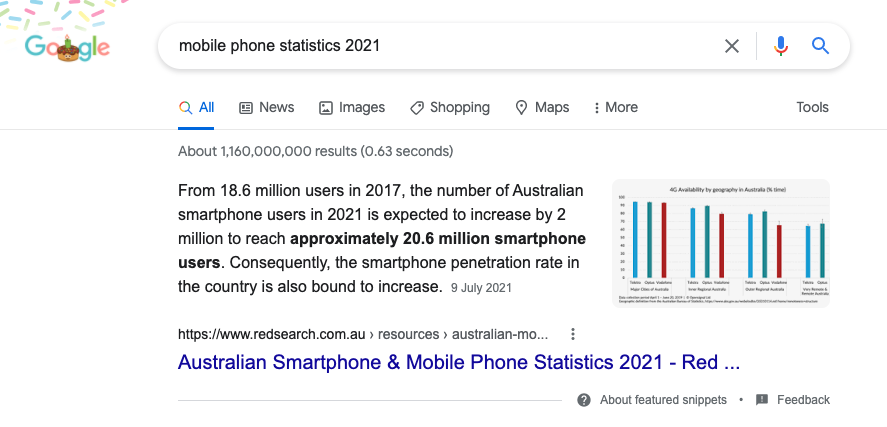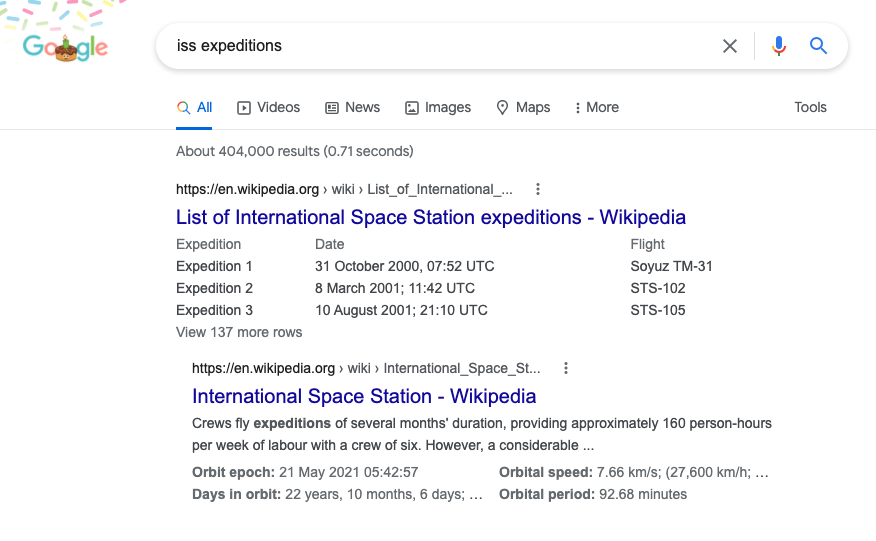
- Red Search
- Resources
- Google Featured Snippets
How to Optimise for Google’s Featured Snippets in 2021
-
 Hans Andrew Consuegra
Hans Andrew Consuegra
When Google first rolled out featured snippets, it became a trophy for websites competing in the top spot of Google SERPs. However, Google didn’t give webmasters much information on earning featured snippets for your keywords.
At Red Search, we have crunched all the facts to give you everything there is to know about featured snippets – providing you with every opportunity to stay on top of your competitors.
Besides, with Google reporting more than 3.5 billion searches every day, optimising your content to leverage featured snippets will undoubtedly generate tons of leads and reward your SEO efforts.
What is a Featured Snippet
If you’ve been using Google for quite some time, you should’ve stumbled upon featured snippets. A featured snippet, also known as Position Zero, is a piece of valuable content that you can find on top of Google search results.
 https://www.redsearch.com.au/resources/australian-mobile-statistics/
https://www.redsearch.com.au/resources/australian-mobile-statistics/
Featured snippets are high-quality information from a well-ranking website that answers a search query directly. Nevertheless, earning a featured snippet will drive significant traffic to the featured page.
You can have your content featured in Google SERPs as a snippet by keeping the following in mind:
- Starting with a “What is” subheading
- Discussing the topic in-depth
- Optimising content structure for a featured snippet format
- Avoid brandishing your company name on all corners.
- Refrain from writing in the first person
- Scale your content for featured snippets
- Aim for the top five spots, because Google picks well-ranking pages for snippets
Additionally, featured snippets have a relatively more straightforward algorithm than Google’s core algorithms. That said, performing simple but effective on-page adjustments can heavily influence your featured snippet ranking, as long as you clearly outline your topic to your readers.
How Do Featured Snippets Work
Featured snippets mainly serve one key objective (among others) — to fuel an intuitive voice search. That’s because when browsing through voice queries or Google Home devices, the search engine reads back featured snippets as a response.
Hence, it only makes sense that the featured snippet must answer the query directly and accurately. Aside from that, Google uses featured snippets to answer the most competitive and frequent search keywords.
As Google stated, featured snippets keep readers focused on the results page. Keep in mind that Google rolled out featured snippets as a way to provide a smooth and intuitive UX. One way to leverage this is to provide concise and accurate answers to frequently asked questions.
In 2020, Google launched the featured snippet deduplication update that removes featured pages from the rest of the organic search results. That way, results pages with a featured snippet will now have ten organic listings, instead of the usual eleven (11) organic links.
What are the Types of Featured Snippets
Looking closely at featured snippets, you’ll see that they come in distinct types depending on the query. You must know the different types of featured snippets to optimise your content structure for them.
The different types of featured snippets are as follows:
Paragraph
The most common featured snippets are paragraph contents. These are excerpts from long-form content that Google pulled out from a <p> HTML element.

List
Featured snippets can also come in numbered and bulleted lists from contents with <ul> or <ol> HTML elements.

Table
Columns and rows of information directly pulled out from contents tagged with a <table> HTML element.

How to Create a Featured Snippet
There are no one-size-fits-all steps to get your content featured as a snippet. However, you can follow these pointers to increase your chances of ranking at position zero:
Create Long-form Content for Long-tail Keywords
Several industries may find featured snippets unpredictable for many keywords. That said, developing a content strategy that targets a broader keyword scope organically will be more efficient than writing an article for every target keyword.
In simple terms, you need to build long-form content that discusses not only the primary keyword but includes relevant concepts and queries. Besides, streamlining a long-tail keyword strategy should benefit your ranking and improve your chances of earning a featured snippet.
Use Subheadings To Organise Your Content
Over the years, Google’s consecutive algorithm updates have focused on improving the user search experience. For brands competing for position zero, how you organise your content can make or break your overall SEO strategy.
We recommend breaking your long-form content into smaller chunks and using relevant headings for individual sections. That way, users can digest every subheading better than seeing massive blocks of text.
Besides, using subheaders also gives you more opportunities to add semantic keywords and frequently asked questions. To top it all off, you can also build an interactive table of contents that points users and search crawlers to the corresponding subheading.
Supercharge Your SEO To Improve Organic Rankings
Whether you like it or not, 90% of featured snippets in Google SERPs are from the top five organic listings. In other words, your efforts to optimise for featured snippets will end up worthless if you’re not on the first page of search results.
Moreover, you can also narrow down to three dominant factors that will influence whether or not your content will rank as a featured snippet:
- Ranking Score — Your existing organic position on the target keyword or search query
- Site Authority/Quality Score — Overall website quality and authority of outbound links
- Reputation Score — Also considered as the page backlink profile, which indicates the page’s reliability and trustworthiness
Leverage Video Content to Rank on Featured Video Snippets
YouTube content accounts for over one million search queries with featured video snippets, making it a crucial platform to leverage.
Along those lines, creating and streamlining search-optimised video content on YouTube lets you earn more featured snippets and effectively convey your message.
YouTube video content also has better chances of ranking on YouTube SERPs and getting featured in Google than ranking to page one from scratch.
Furthermore, some large-scale businesses with considerable SEO budgets still shy away from video content as they find it costly and complicated. But today, not only is video content doable, but leading Australian brands find it more engaging and useful.
Optimise Images for Featured Snippets
Often, featured snippets will take on a visual approach by highlighting photos and image carousels. Say you earned a featured snippet on one of your pages, but if it lacks relevant images, it will force Google to display pictures from your closest competitors.
So if you want to maximise your featured snippet for optimal brand visibility, always include relevant and web-optimised images on your pages as part of your overall SEO strategy.
Tips in Featured Snippet Optimisation for 2021
Winning the race to position zero means crafting a cunning strategy to outperform your competitors. To earn your spot as a featured snippet, you must construct your content correctly.
If executed properly, you can even overwrite an existing snippet with your content — given that your content provides a precise and accurate answer for the query.
That said, these on-page SEO elements rundown should give you a heads-up on how to kickstart and maintain rich content targeted for position zero:
Choose the Right Keywords
Remember that synonyms and latent semantic indexing (LSI) keywords are closely related but distinct from each other. For instance, the word apple is synonymous with the fruit — but Apple can also mean the smartphone.
LSI keywords should give direction and context to your primary keyword, so Google understands your content and indexes it in the right place.
From the example above, semantic keywords for Apple can be smartphones, mobile devices, technology, and iOS. Those keywords draw the line between the fruit and the smartphone, so you must pick the right keywords strategically.
Moreover, the longer the key phrases are, the higher the chances of Google SERP responding with a featured snippet.
According to SEMrush:
- 4.3% of one-word queries displayed a featured snippet;
- 17% of five-word questions had a featured snippet;
- 55.5% of long-tail keywords with more than ten words had a featured snippet
Along with those figures, long-tail search queries reveal user intent better than shorter keywords. That’s why Google searches would return with a snippet to answer the user intent directly.
Leverage Question-Based Queries
SEMrush also found that almost 30% of searches that returned a featured snippet were question-based keywords like why, can, what is, and others. Before you head out and write fresh content, take note of the following statistics:
- 72% of search queries begin with can
- Roughly 78% of keywords start with why
Search queries that start with where only have about a 19% chance of triggering a featured snippet. That’s because Google uses Local Packs when it detects a local search intent or a where query (think local SEO).
Optimise Your Formatting for Featured Snippets
At this point, you should have a firm idea about the ideal formats for featured snippets: paragraphs, lists, tables, and video content.
As you write long-form content for your chosen keywords, using the above formats throughout your content improves your chances of getting featured. You can also enhance your content’s legibility. That’s because it’s easier to interpret enumerations and lists when organised in bullets or tables.
But only use these formats sparingly and when needed. It’s best to keep your lists and bullets about 30-50 words or 200-300 characters.
Resize Your Images for Snippets
If you’ve been performing on-page SEO for quite some time, you should know that using high-resolution images isn’t always the best option, especially for featured snippets.
Google uses its Image algorithm to select and load images in the featured snippet, and it can sometimes load cropped images poorly. To avoid this from happening, keep your image ratio close to 160 x 200px. For better snippet thumbnail quality, consider scaling up your images to 960 x 1200px.
Consider Dating Your Content
Several sites would hide dates from their blog posts to sound evergreen and relevant for as long as possible. But this technique has its own set of drawbacks, especially for readers who visit your site for research. Aside from that, it can also be detrimental to earning featured snippets.
That’s because featured snippets display dates on ranking content. Out of the four common types of featured snippet formats:
- 44% of paragraphs included a date
- 47% of lists show dated content
- 19% of tables had a date
- And 20% of video content displays a date
Additionally, about 70% of featured snippets in 2020 have dated content that ranges within the past two to three years. And from what we know, the chances of Google removing dates on featured snippets is meager to impossible.
After all, dating your content helps build trust and reliability for your readers, as it tells them that you’re updating your content with up-to-date and relevant information.
Monitor your pages that perform excellently, and once their click-throughs and conversions begin stagnating, consider updating them with the latest information. Besides, what are the odds that more recent search results will have a better click-through rate than the rest?
Build Content Hubs to Target Featured Snippets
If you’re a large-scale website that provides content for various resources, you can consider streamlining them into different content hubs. These are subfolders you can use to organise content such as marketing, creative, and SEO, among others.
The end goal of building content hubs is to pick content from your chosen subfolder and format it into a featured snippet hub. By definition, a featured snippet hub is a URL or video content that can earn as much as ten or more featured snippets.
If performed correctly, you can benefit from featured content snippet hubs by:
- Earning multiple featured snippets
- Keeping the reader engaged with actionable information
- Making the content easy to crawl and index
Following the above tips, you can streamline a reliable featured snippet strategy that will reward your site with better visibility and trust. But it takes patience to earn and maintain a featured snippet for your target keywords.
Conclusion
Earning a featured snippet provides a sheer number of opportunities for your brand. You can also outperform the competition by ranking at position zero, boosting your site authority to your target consumers.
You should consult an experienced SEO agency or consultant for the best results in achieving this.
Additionally, it takes careful keyword research and content structure optimisation to have Google feature your content in SERPs as a snippet. That said, crafting amazing and unique content to answer a query best will reward you with improved consumer retention and acquisition.
Written by





